The Auto Takes Hold
In less than two decades automobiles grew from curiosity to commonplace in these hills.
On a warm Sunday afternoon in the summer of 1903 an “auto” was spotted driving through Orangeville. It didn’t stop, but in the next issue of the Orangeville Sun the sighting was a lead item in the local news column. There were only 178 registered cars in the entire province that year, so to have one in town, even just passing through, qualified as real news. Not for long, though. Two years later, local newspapers were reporting about residents who actually bought cars and were driving them. It even became a matter of community pride. In 1906, when J. W. Shields of Grand Valley became a buyer, the Star & Vidette appeared relieved to announce, “The village finally sports an automobile!”
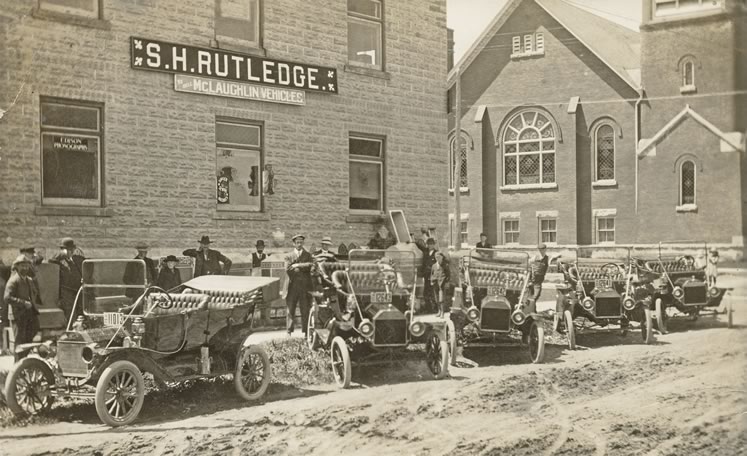
S.H. Rutledge opened an early dealership on Owen Sound Street in Shelburne (shown c.1920), selling McLaughlin automobiles. Photo Courtesy Dufferin County Museum And Archives.
Suddenly too many?
For the next several years, lists of new car owners appeared regularly in the community press, although in a May issue in 1912 the Sun had even more auto news. In addition to noting the four new buyers in town (and one in Alton), the paper announced that F.H. Doherty was opening an “automobile garage” in the Beatty Block “to serve the increasing number of autoists in the area.” It was a controversial development, coming at the same time as merchants along Broadway were agitating for a bylaw to ban autos on Saturday night – because they frightened the horses that shoppers tied to hitching posts outside their stores.
A momentum not to be stopped
Although the bylaw failed, it was an indication that by 1912 there were already enough cars around to be considered a nuisance. Not that it made a difference for there were more and more of them all the time. In 1917, for example, when John Rayfield came home from his war service in France, the welcome parade that cheered him from the Orangeville railroad station to his home in Camilla included no fewer than 40 cars.
Any remaining doubt that cars were here to stay was set aside by the Orangeville Banner’s account of the 1918 fall fair. According to the Banner, there were as many as 600 cars in town for the fair, parked two and three deep around the racetrack and blocking spectators’ views. Cars also lined both sides of Second Street from the fairgrounds to Fourth Avenue, making it almost impossible to get through. The “auto” was no longer a novelty here. In little over a decade, it was becoming thoroughly woven into the fabric of life.
Who was buying them?
By 1913 local newspapers had given up declaring their communities were “joining the 20th century” (a popular advertising phrase) by proudly listing the names of car buyers. Still, in Grand Valley that year, the Star & Vidette couldn’t resist telling readers that E.H. Glenn, principal of the village school, along with Alf Sanderson and Dr. Perkins had each bought five-passenger McLaughlins within days of one another.
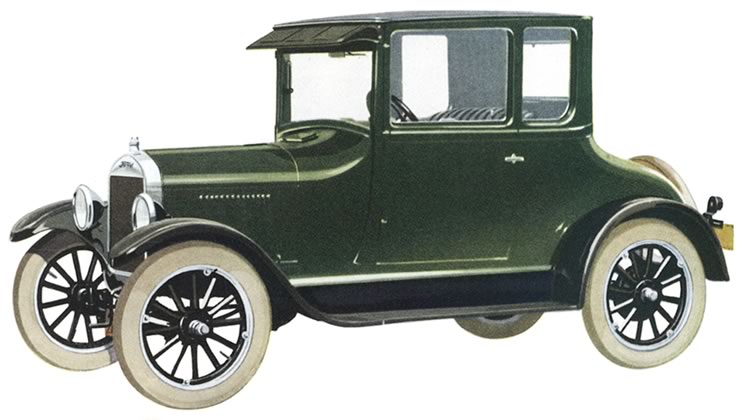
The Ford Model T Coupe was popular among country doctors for, among other reasons, an enclosed cabin that would protect them from the elements when making house calls.
Over time this kind of reportage created the impression that car buyers tended to be “townies,” who bought one for convenience and possibly status. However, in 1917, Bolton’s Ford dealer, T.D. Elliott & Son (where horse and buggy rental was also available), ran a large and detailed advertisement in the Brampton Conservator that suggested otherwise.
Farmers were important customers
The ad quoted data from a Ford Motor Co. survey of nearly 10,000 buyers of Ford cars, listing them under 57 occupational categories. Doctors, for example, represented 2.1 per cent of buyers, salesmen 2.7 per cent and building contractors 1.3 per cent. The eye-opener was the agriculture category. More than half the Fords (52.2 per cent) in the survey were owned by farmers.
The preponderance of rural purchasers may be partly explained by the famous Model T. It was inexpensive, simple to operate and sturdy, and for a farmer there was particular appeal in its high riding chassis. The “tin lizzie” could be driven on rough rural roads, down rutted farm lanes and over ploughed fields with its underside undamaged.
Shelburne Free Press, originally one of the louder anti-auto voices, editorialized in 1917 that “The auto is rapidly winning its way into general use by agriculturalists,” confirming that when a horse and farmer met a car on the road, the driver was just as likely to be another farmer.
A passing tension
Even as farmers purchased more cars, though, the dangerous conflict between horse and auto persisted for a few more years. In both town and country, the issue was sharing the road – because horses were easily spooked by the looming, noisy beast on wheels. In May 1914 (probably the worst year), Mulmur Township reported nearly a dozen serious runaways. There were fatalities in both East Luther and Melancthon townships that month, and everywhere in the hills stories abounded of horse and auto encounters that ended badly.
Nevertheless, just a few years later in 1918, the year so many cars flooded into the Orangeville fairgrounds, the press reported very few horse-and-auto confrontations, suggesting both sides were learning to adapt.
Town and country in it together
Factored into the accelerating popularity of cars was a degree of freedom and convenience both townspeople and farmers had never experienced before. Until the arrival of the auto, the only way to get from one place to another was by foot, train (a welcome addition but with defined schedules and routes) or, most often, horse. Of all these, the horse was probably most useful, but also most demanding, with its daily need for feeding, care and accommodation, never mind the required pre- and post-trip attentions.
Such considerations would surely have resonated with readers when, for example, the Orangeville Banner reported in 1919 that “The Tates of Caledon East motored to East Luther on Sunday for a visit with family.” Likewise, when the Shelburne Free Press reported that “W. J. Loudon had moved family and effects to Barrie with an auto and trailer in only two hours,” many readers were probably similarly impressed, if not envious. And wanting a car.
A natural part of life
Just how thoroughly the auto had infiltrated these hills from that first Orangeville sighting in 1903 is illustrated by an event in Bolton on June 28, 1918, attended by “a monster crowd,” in the words of the Bolton Enterprise. The reason was neither civic, nor religious, nor patriotic. The crowd was there solely to see the newest model of the Chevrolet in a show put on by Bolton dealer T.A. Dick. And it seems Mr. Dick came through. There was a band, a parade of new cars, a bit of “magic” (see sidebar), executives from Oshawa’s Chevrolet plant delivering speeches, plus a promise the show would repeat the following year, and show off a Chevrolet with an eight-cylinder motor and multiple new features.
That promise drew rapt attention. It seems the thrill of anticipating next year’s models, a notion that would carry on for decades, had already settled into the local psyche. As the Orangeville Sun put it in an advertorial touting Maxwell cars: “We can no longer get along without motor cars than we can without the telegraph or telephone.”
More Info
Dick’s Trick
At a key point in the parade of Chevrolets he organized in Bolton in 1918, local dealer T.A. Dick got out of the one he was driving while it was moving. The apparently driverless car kept going and went on to perform circles and figure eights. It then backed up to retrieve Dick who got back behind the wheel. The performance thoroughly impressed the crowd, but like any good magician, Dick kept his method secret.
Automobile College
Although Grand Valley did not announce its first car owner until July 1906, it was one of the first communities off the mark in the service category. In February that year, Horace Tolton returned to the village after a month at Boston Automotive College prepared to offer his newly acquired skills – not maintenance and repair, but driving lessons. Most new car owners in the early days had no idea how to drive.
Related Stories
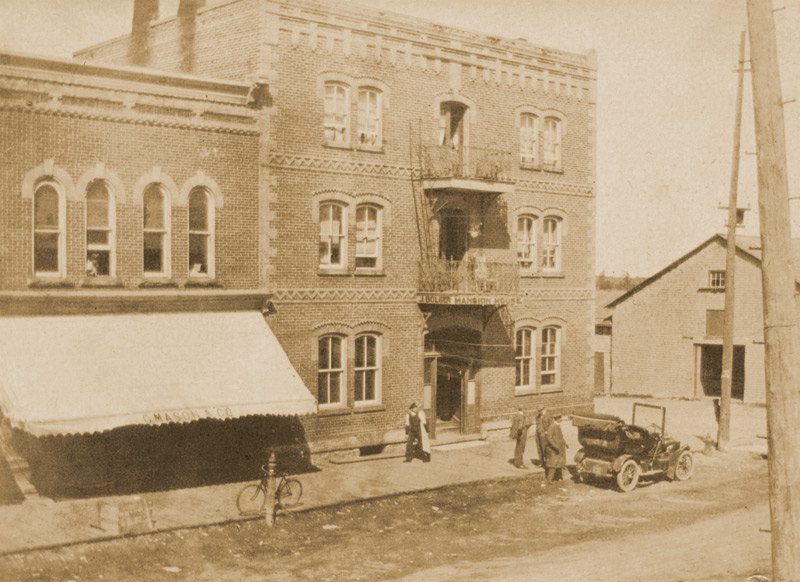
Natural Enemies: Horse vs Automobile
Sep 15, 2008 | | Historic HillsJust over a century ago the horseless carriage chugged into these rural hills and ran head on into a horse-reliant culture. What began as a novelty soon became a nuisance, sparking a battle for supremacy on the roads.
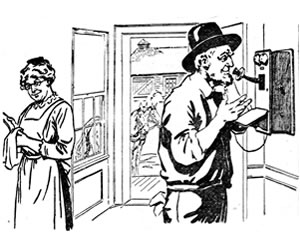
The Bob Edgar Telephone Company
Sep 11, 2014 | | Historic HillsBeginning in the late 1920s, though, a series of government regulations along with profit-driven business decisions gradually changed telephone service across the country into a fluid network.
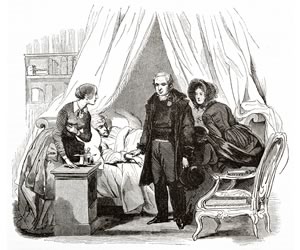
Once Upon a Time There Were House Calls
Sep 11, 2013 | | Historic HillsBefore the days of clinics, emergency rooms and office hours, most medical treatment took place in a patient’s home. It was a challenging and uncertain process, and not just for the patient.










